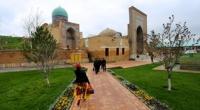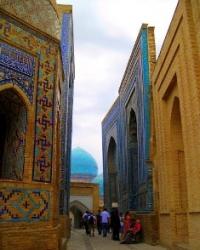You are here
Shadi-Mulk-aka mausoleum.



Excursion trip in Samarkand.
"I saw so much grief from friends
And so much misery and torment washed tears
That in the hour of death it is better to die,
How to survive and live with friends again”
Alisher Navoi.
Travel around the cities of Uzbekistan.
One of the earliest on the Shakhi-iZinda funerary-mausoleum complex is the mausoleum of Timur’s niece - Shadi-Mulk-aka. The mausoleum of Shadi-Mulk-aka (the second from the left) is dated 773 AH (1372). For a long time this monument in scientific literature was known as a mausoleum over the grave of Timur's wife - Tuman-aka).
Of the entire group, Shadi-Mulk's mausoleum stands out with luxurious furniture. The decor and other buildings are striking with the perfection of compositional and color solutions, the subtlety and grace of the embodiment of the master builder’s plan.
Truly inexhaustible variety of artistic means in the art of ceramic facings Shahi-3inda. Terracotta with carved plant, geometric and epigraphic ornamentation, covered with colored glaze, and majolica make up the lining of most of the mausoleums of this complex.
This group of mausoleums ends with the tombs of representatives of the royal house of Timurids. On the tomb of Shadi-Mulk one can read the names of Bareddin and Shamsetdin - masters from Samarkand and the name Zainutdin from Bukhara, written on the base of the column.
The detail of the facing of the mausoleum built in the 1380s contains the name of the master Ali Nesefi from Karshi, and on the figure sheet of the plant ornament of the mausoleum of Haji Ahmad the name of the Samarkand Fakhri Ali is written.
Professor M.E. Masson, on the basis of a study of the inscription on the portal, suggests that this is the mausoleum of Shadi-Mulk-aka, the daughter of Timur’s elder sister, Kutlug-Turkan-aka, who died in 1383. It is possible that Timur’s sister was buried next to her daughter in the same crypt.
This best-preserved mausoleum was probably erected by the will of the mother over the grave of Shadi-Mulk-aka, who died in 1372. The said mausoleum is the first construction of Timur’s time in Shah-i-Zinda. Its corner columns are covered with fine carvings and stand on complex figured bases.
Slender columns that support the arch, crowned with stalactite capitals. The side walls of the niche are lined with beautiful majolica panels. The interior of the mausoleum is decorated with majolica tiles. Judging by the preserved inscriptions, this monument was erected, like other mausoleums of the architectural ensemble of Shah-i-Zinda, the old masters of Uzbekistan.
In the 1930s, capital works were carried out to strengthen the portal.
Enlightener:
"Religious and spiritual monuments of Central Asia." Author M. Khashimov. Saga Publishing, 2001 Collection “Architectural and archeological monuments of Uzbekistan”, Saga, 2003. “Samarkand. Reference Guide ", Authors I.Umnyakov, Y. Alekserov. Arapov A.V. Samarkand "Masterpieces of Central Asia". Media-Asia San’at Publishing House 2008. Arapov A.V. “Samarkand. Guidebook Publishing house Media-Asia San’ath 2007.
Photos by
Alexander Petrov.
Excursion trip in Samarkand.
Travel around the cities of Uzbekistan.







